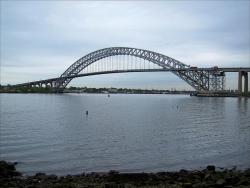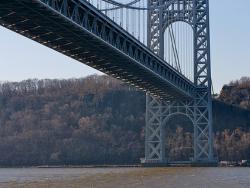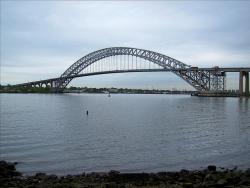Perhaps no twentieth-century engineer has left a more visible mark on a major city than has Othmar Ammann on New York. His five major bridges there bear much of the enormous traffic flow to and from the city while requiring remarkably little maintenance. They are beautiful and efficient structures, for Ammann achieved an uncommon harmony of visual elegance, simplicity, and power with practical design. But that harmony developed slowly.
Ammann, Othmar
NEW YORK, N.Y. : The Greenwich Village air was sweet with the smell of burning tar, which mingled with souvlaki and honey-roasted peanuts in an olfactory mosaic. Staccato bursts of jackhammer noise, accompanied by equally rapid-fire cursing from road workers, served as percussion for the usual symphony of ambulance sirens and car horns. Weak sunlight filtered gamely through the smog; most blocks had at least one sidewalk passable; in short, it was the perfect day for a stroll down to Cooper Union to talk about the infrastructure.

The Triborough Bridge Project is a three-branched waterway crossing that connects Manhattan, the Bronx, and Queens at a junction of the East River and the Harlem River in New York City. The complex structure includes a suspension bridge from Wards Island to Queens, a vertical lift span from Randall's Island to Manhattan, a fixed span (designed to be convertible to a lift span) across the Bronx Kills, viaducts, and an innovative three-legged roadway interchange.

The longest steel-arch bridge in the world for 46 years, the Bayonne Bridge continues to be celebrated today as a major aesthetic and technical achievement. The 1,675-foot bridge replaced a ferry service which until then was the only means of crossing from the Bayonne peninsula to Staten Island. While providing this essential link in the transportation network of greater New York City, the bridge's mid-span clearance of 150 feet also allows for unobstructed navigation on Newark Bay, the main shipping channel to the inland ports of Newark and Elizabeth, New Jersey.

"An essential part of the human experience is to create an aesthetic atmosphere."
The George Washington Bridge represented a departure in suspension bridge design. Chief Engineer O.H. Ammann developed a system of stiffening trusses that offered greater flexibility and saved the project nearly $10 million. Initially, just six of the upper eight lanes were paved, but Ammann designed the bridge to easily accommodate a future lower level.
Swiss-born O.H. Ammann (1879-1965) was Chief Engineer for the Port Authority of New York and New Jersey during the bridge's construction.
Innovations

"An essential part of the human experience is to create an aesthetic atmosphere."
The George Washington Bridge represented a departure in suspension bridge design. Chief Engineer O.H. Ammann developed a system of stiffening trusses that offered greater flexibility and saved the project…
Read More
The longest steel-arch bridge in the world for 46 years, the Bayonne Bridge continues to be celebrated today as a major aesthetic and technical achievement. The 1,675-foot bridge replaced a ferry service which until then was the only means of crossing from the Bayonne peninsula to Staten Island…
Read More
The Triborough Bridge Project is a three-branched waterway crossing that connects Manhattan, the Bronx, and Queens at a junction of the East River and the Harlem River in New York City. The complex structure includes a suspension bridge from Wards Island to Queens, a vertical lift span from…
Read More

